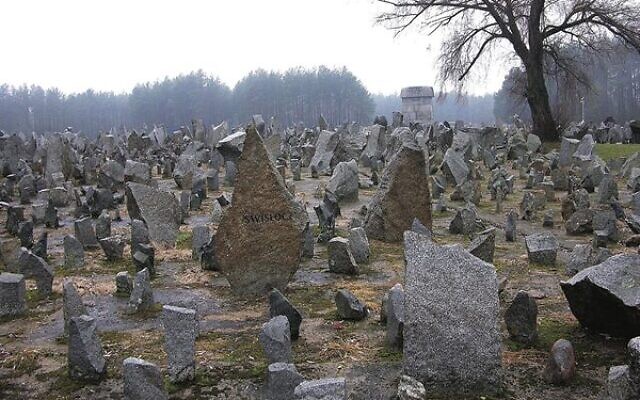Remembering the Treblinka Uprising
When we reflect upon the Holocaust, it is important to remember not only that Jews were victims, but also the acts of resistance.
August 2 marked 80 years since the Treblinka Uprising – when Jewish prisoners courageously staged a revolt in a bid to destroy the death camp and escape.
When we reflect upon the Holocaust, it is important to remember not only that Jews were victims, but also the acts of resistance – the large acts of rebellion, as well as the small acts of defiance.
The tragic history of the Treblinka death camp is not widely known, and yet around 925,000 people were murdered there. According to the Memory of Treblinka Foundation, it is “the largest cemetery of Polish Jews”.
Treblinka was one of the main sites for “Operation Reinhard”, the Nazi plan to kill around two million Jews within German-occupied Poland, as part of its “Final Solution” to systematically murder Europe’s Jews.
The death camp had a small forced labour site at Treblinka I, and an extermination site at Treblinka II. When prisoners arrived at Treblinka II, their clothes and possessions were removed before they were forced to run naked through a tunnel towards the gas chambers, which were deceptively labelled as showers.
After months of planning, on August 2, 1943, the inmates staged an uprising. According to the US Holocaust Memorial Museum: “The prisoners quietly seized weapons from the camp armoury. However, they were discovered before they could take over the camp. Hundreds of prisoners stormed the main gate in an attempt to escape. Many were killed by machine-gun fire. More than 300 did escape – though two-thirds of them were eventually tracked down and killed by German SS and police, as well as by military units. Surviving prisoners were forced to dismantle the camp … After completion of this job, the German SS and police authorities shot the prisoners.”
By November 1943 Treblinka was dismantled. Of the prisoners that escaped, only 67 people are known to have survived.
On August 2 this year, a movie was released by JewishPlock EU, called The last path of their lives. People of Płock in the Uprising in Treblinka. The movie was aimed at remembering the role of Jewish citizens from Płock that were involved in the uprising – included among them, my great-grandfather Chaskiel Rozenberg and his son Szmul.
Summarising the movie, its website states, “People from Płock were a pillar of the uprising. Motek Perelgryc … He and his friends Łyk from Nowy Dwór and Budnik with his brother forged the key to a German weapon warehouse, they made an imprint of the key using a piece of bread. Treblinka counted nearly a thousand prisoners, and there was no one to voluntarily enter the weapons warehouse. Only Chaskiel Rozenberg and his son Szmul Rozenberg volunteered. They were let into the arsenal with weapons and they issued German automats and grenades to the insurgents through the bars. Chaskiel Rozenberg was the commander of his timber group, and in the underground he was one of the organisers of the uprising in Treblinka. He was killed during the fights. His son, Szmulek, died in the forest during the siege conducted by the Germans from outside the camp, near Treblinka.”
Chaskiel’s other two sons – Mordka and Abram, were killed in the gas chambers of Treblinka. His daughter, Bronia – my grandmother – did not go to Treblinka; she was sent to HASAG factory and was liberated from Bergen-Belsen. She passed away when I was six years old, and I knew very little about her experience in the Shoah or about her family.
As grandchildren of Holocaust survivors, sometimes we were too young to know to ask, sometimes we wanted to ask but didn’t want to upset our grandparents by triggering traumatic memories, and sometimes our grandparents were not ready to tell.
Now I have no grandparents alive to ask, but what I do have access to are new databases as more and more information becomes available online. The accessibility of online records, and shared international resources, such as films and recorded testimonies, enables us to tap into historical records that were previously not accessible.
When I first started researching my family history, I could not have imagined that I would find a movie about my great-grandfather – giving voice to his story and preserving his legacy.
Meanwhile, the stories of other family members – such as my great-grandparents Shmuel and Dora Lurie – remain a mystery. My grandfather Bill Lurie came to Australia shortly before WWII and never found out what happened to his parents and brother Jurek. The “not knowing” has been a constant source of pain to my family. But with new sources of information available online, I am determined to search for answers.
It could be that they died at Treblinka, as so many Jews from Warsaw were sent there. Part of the role of the Memory of Treblinka Foundation is to record the names of those who were killed at Treblinka in order to preserve the memory of those murdered. To date, they have collected over 8000 names that were previously not documented anywhere else.
As survivors pass away, the responsibility to honour the memory of the Holocaust is shifting to the next generations. With online resources becoming more accessible, the duty of preserving the legacy of victims and survivors of the Shoah rests not only with museums and foundations, but with each of us.
Sharyn Kolieb is the deputy editor of The AJN.


comments